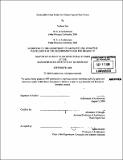Sustainable urban forms for Chinese typical new towns
Author(s)
Son, Sunhwa, 1980-
DownloadFull printable version (44.72Mb)
Other Contributors
Massachusetts Institute of Technology. Dept. of Architecture.
Advisor
Alexander D'Hooghe.
Terms of use
Metadata
Show full item recordAbstract
The phenomena of exploding world urban population and sharply decreasing global arable lands are illustrated in contemporary China in a dramatically amplified form. Construction of many new towns in rural areas has been accelerated due to vigorous economic growth and immigration of people to urban areas. Many such new towns deal with their sustainability as a fundamental goal. However, these new towns are not demonstrating whether their urban forms are effectively responding to the principles of sustainability, going beyond plausible visual images. This study, through the application of sustainability principles to the examination of plans in new towns, proposes alternative urban forms for typical Chinese towns constructed in the countryside. Reviewing practices relevant to sustainability, the study draws out the consensus urban models and principles for sustainable development. The paper also investigates how new town plans differ from both historic capital cities and the work units of the Maoist period, classifying them into four types based on featured visual elements. Last, this thesis proposes linear networking compact cities as a model for typical micro-scale towns. Constructing linear urban blocks along an integrated efficient infrastructure, the maximum natural landscape is preserved intact. This study attempts to inspire further studies and attention to desirable sustainable urban forms for Chinese new towns.
Description
Thesis (S.M.)--Massachusetts Institute of Technology, Dept. of Architecture, 2008. Vita. Includes bibliographical references (leaves 80-81).
Date issued
2008Department
Massachusetts Institute of Technology. Department of ArchitecturePublisher
Massachusetts Institute of Technology
Keywords
Architecture.